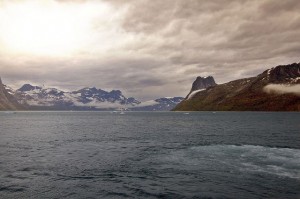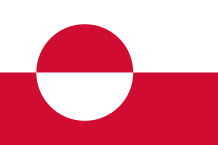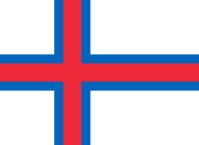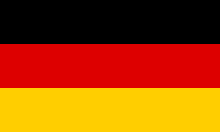The Scotlands of Denmark Posted by Bjørn A. Bojesen on Sep 27, 2014 in Uncategorized

Greenland. (By Boegh. Licensed under Creative Commons on Flickr.)
Last week the people in Scotland voted no to becoming a country independent from the United Kingdom. For some people in faraway countries, it was maybe the first time they saw the Scottish flag or even heard about Scotland. I want to make sure that you, i det mindste (at least), hear about the parts of Kongeriget Danmark (the Kingdom of Denmark) that aren’t culturally Danish:

“Flag of Greenland” by Jeffrey Connell (IceKarma) – Own Work. Licensed under Public domain via Wikimedia Commons.
– Grønland or Kalaallit Nunaat (in Greenlandic) is a huge island country to the east of Canada. The 50.000-something inhabitants live in bygder (settlements) ved kysten (by the coast); indlandet (the inner parts) of the country is just as white as it looks on Google Maps, thanks to Indlandsisen (the ”Inland” Ice Cap). Most people are grønlændere (Greenlanders) and speak grønlandsk (Greenlandic), although there’s also a considerable number of Danish-speakers. For centuries, Greenland was a koloni (colony). First Norway felt like owning the island (since the first Europeans there had been Vikings from Iceland, which was part of Norway in the Middle Ages). Then Norway entered a union with Denmark (or became a colony itself, depending on your point of view!), and when Denmark ”lost” Norway in 1814, the Danes kept the ”North-Atlantic colonies”: Grønland, Færøerne and Island (Iceland, which is now as free as a puffin). Phew, this is going to be a long passage! 🙂 Anyway, since 2009 Grønland has had selvstyre (home rule). That means that Greenland gets to decide most of its own affairs like any country would do. If Canada tried to invade the island, however, they would still have to fight the Danish army. And if China wanted to drill for oil, they would have to talk with both the Danish and the Greenlandic government. (Isn’t it so, Greenlanders?) People in Greenland often talk about going fully independent. So far, it’s been a bit tricky, as Greenland gets a lot of money from Denmark each year. This money is called bloktilskuddet (”the block subvention” – yawn!), and it would go away like a rainbow if the Greenlanders cut the ties. There are two Greenlandic MPs in Folketinget (the Danish parliament).

Merkið (The Sign) is the name of the Faroese flag. • “Flag of the Faroe Islands”. Licensed under Public domain via Wikimedia Commons)
– Færøerne or Føroyar (in Faroese) is a tiny, rocky and green island group somewhere between Iceland, Scotland and Norway. There are almost 50.000 færinger (Faroe Islanders) on the øer (islands), and an innumerable population of får (sheep). The færinger are of Scandinavian stock like most Danes, and they speak a language – færøsk – that is halfway between Icelandic and Norwegian. Almost everyone speaks fluent Danish as well. Færøerne were settled by Vikings, mostly from Norway. The islands became Norwegian, and later Danish. The similarities with Greenland go on: The færinger have got selvstyre as well, and are represented in Folketinget with two MPs. And they also receive a lot of financial support from Denmark, which is why some Faroese people find it hard to split completely from Rigsfællesskabet (the ”community of the Realm” – a kind of Danish mix between the United Kingdom and the British Commonwealth). When I visited the islands in 2007, the Faroese seemed to be quite fond of the Danish Queen, Margrethe II. As a Dane, however, I felt there were certain things that I should rather not ask about. 🙂

“Flag of Germany”. Licensed under Public domain via Wikimedia Commons
I should also mention tyskerne (the Germans) in Sønderjylland (Southern Jutland). The border between Denmark and Tyskland (Germany) has been shifting quite a few times; as a result, there is a Danish population in Germany and a German population in Denmark. Most of the Germans that are native to Sønderjylland, however, don’t speak German as their main language at home anymore, and are in the minority, so I doubt they’ll get a Scotland-style referendum anytime soon! 🙂

Build vocabulary, practice pronunciation, and more with Transparent Language Online. Available anytime, anywhere, on any device.
About the Author: Bjørn A. Bojesen
I was born in Denmark, but spent large parts of my childhood and study years in Norway. I later returned to Denmark, where I finished my MA in Scandinavian Studies. Having relatives in Sweden as well, I feel very Scandinavian! I enjoy reading and travelling, and sharing stories with you! You’re always welcome to share your thoughts with me and the other readers.




Comments:
A Friend:
The UK isn’t the same as England, so your comparison doesn’t work and is misleading about the relationship between the various nations which make up the UK.
Further, Denmark is monocultural, the UK is multicultural.
Bjørn A. Bojesen:
@A Friend Hello Friend,
You’re right that the UK is not England. However, to some extent, England, Northern Ireland, Wales and Scotland are all ruled from London.
Similarly, Greenland, the Faroes and Denmark are all ultimately ruled from Copenhagen. (Even if the local assemblies are gaining more power, in the Danish Realm as well as in the UK.)
Please re-read the article. I’m talking about the Danish Realm, which can indeed be compared to the UK in a couple of ways.
I thought the Scottish Referendum was a nice way to throw some light on the minorities that are ruled by the Danish Queen. 🙂
I don’t agree with you that Denmark (without Greenland or the Faroes) is monocultural. Traditionally, there is a German community in the south. Nowadays, Denmark is changing, as more immigrants have arrived form other countries.
I appreciate your comment!
Kind regards,
Bjørn